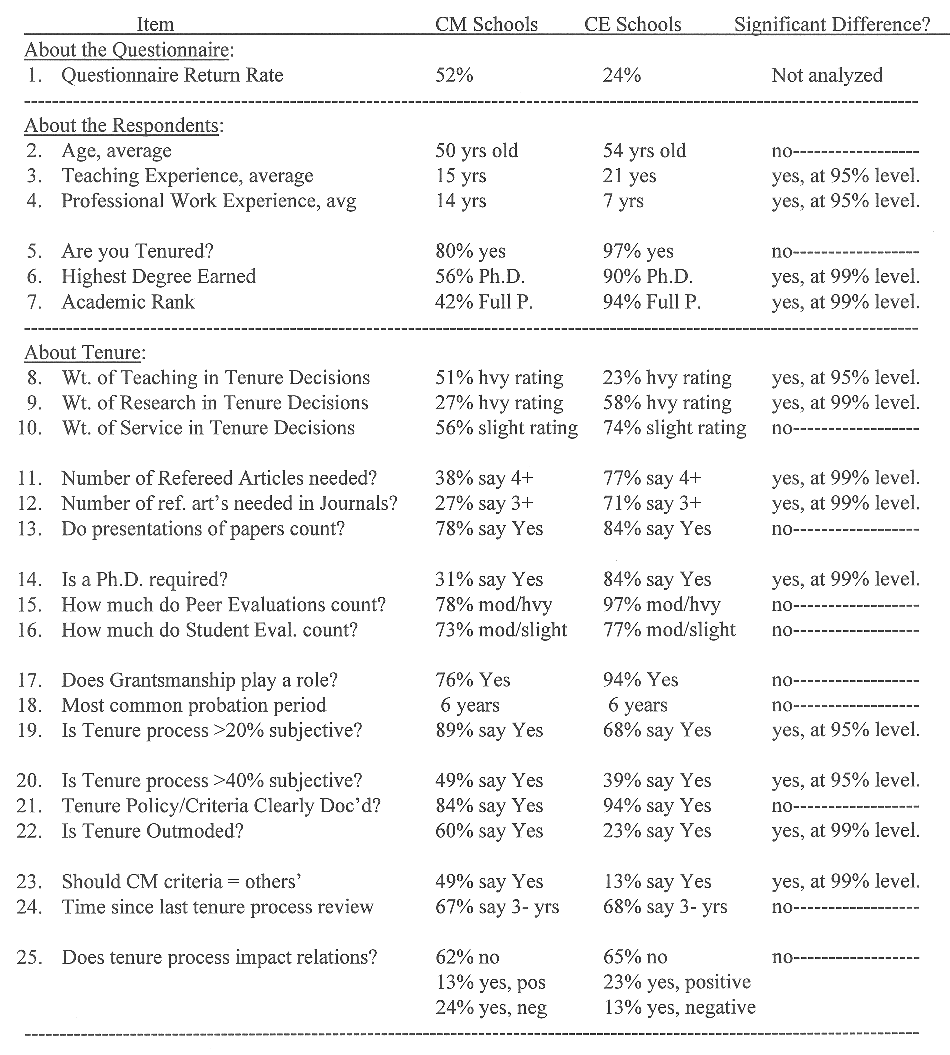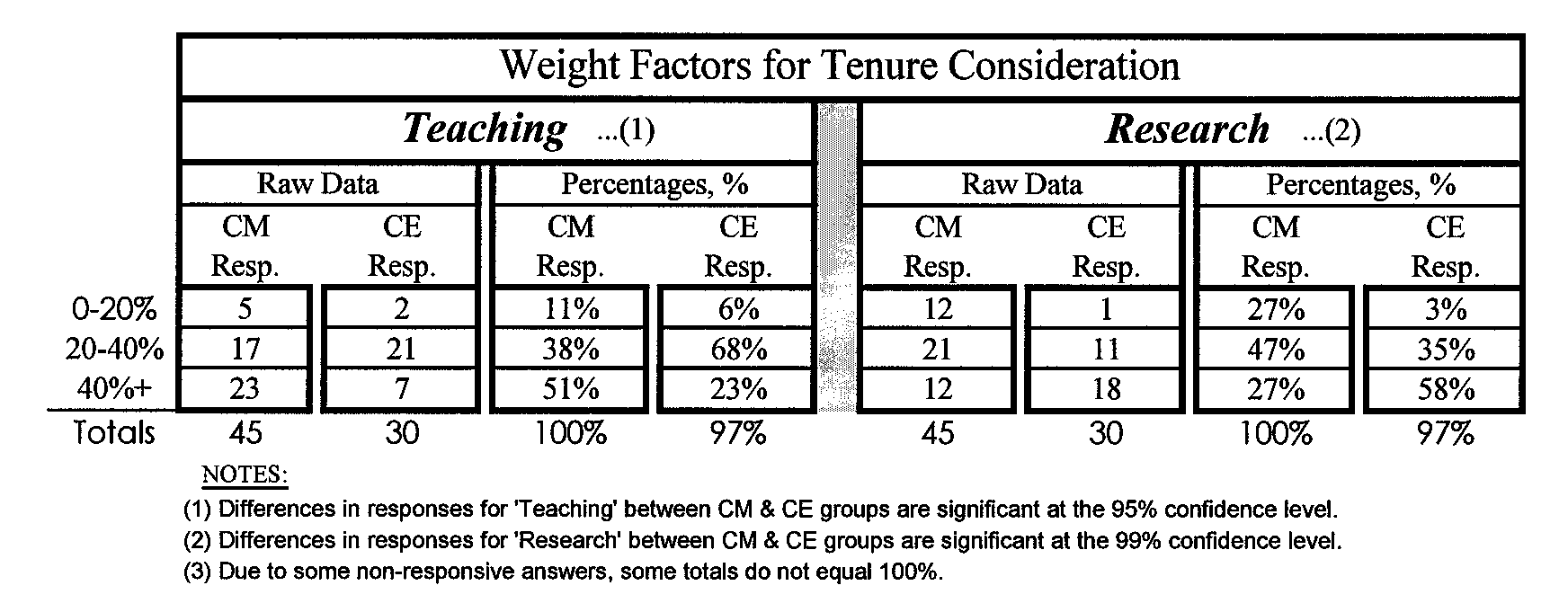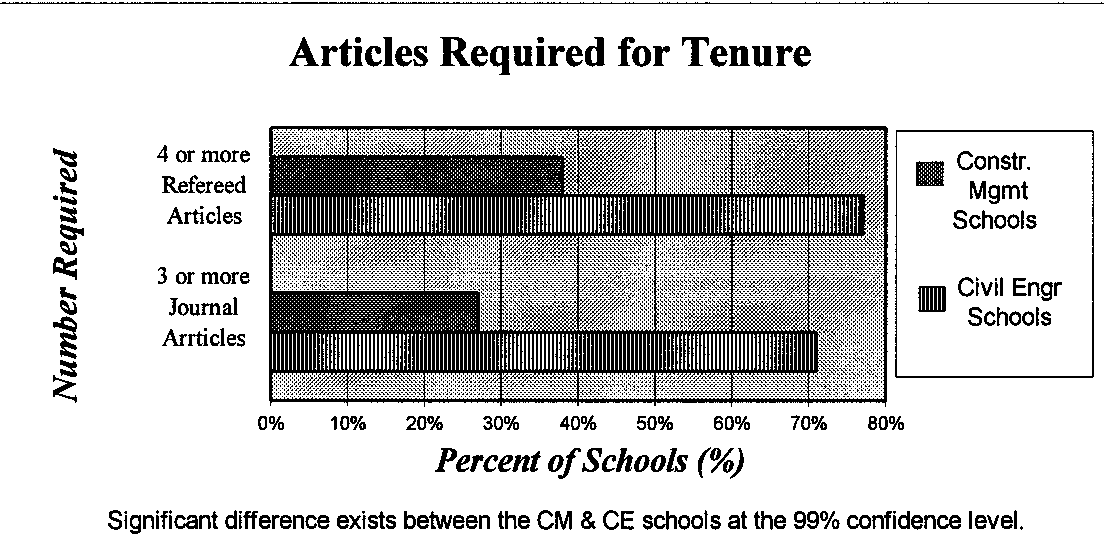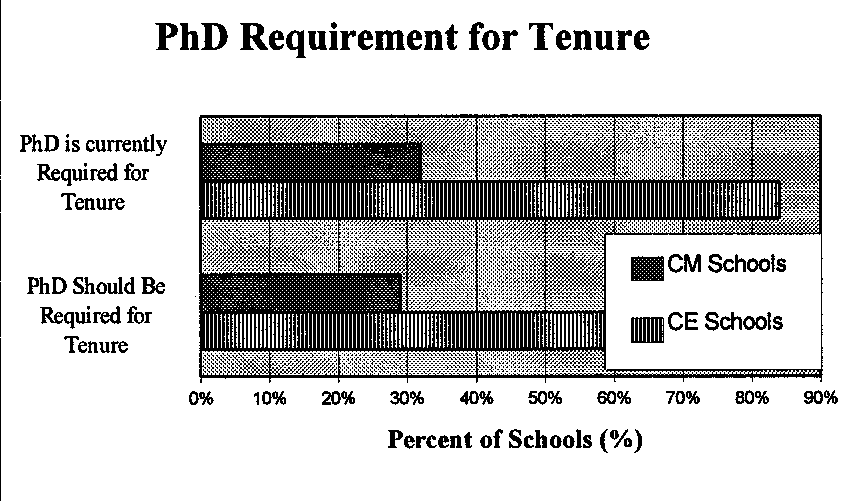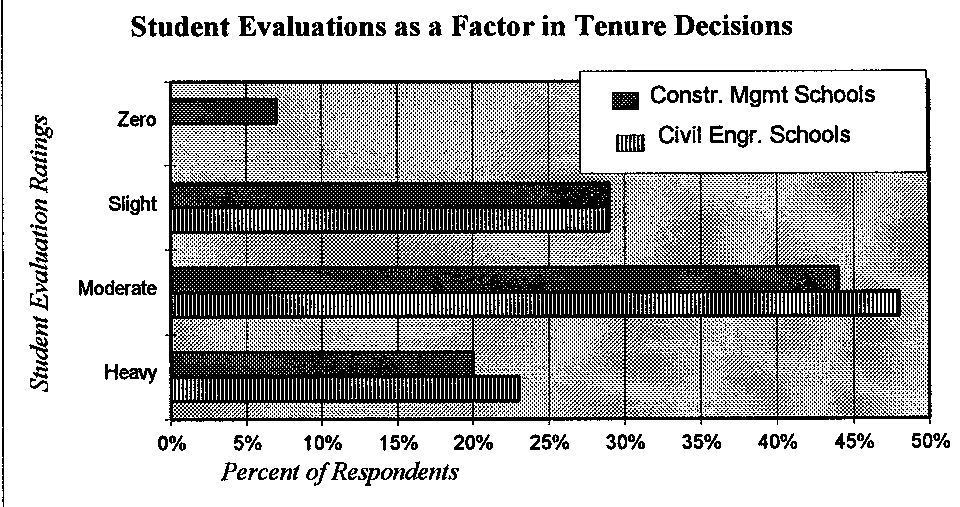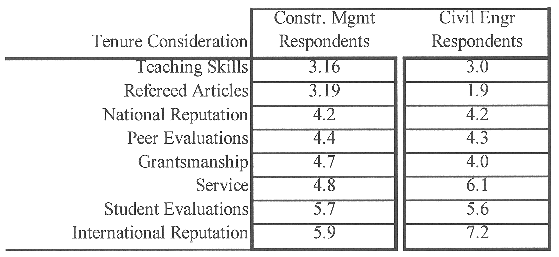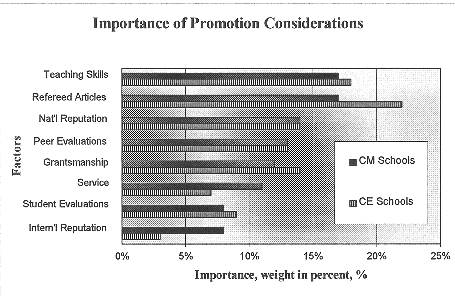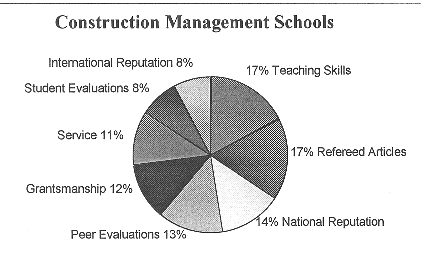|
(pressing HOME will start a new search)
|
|
TENURE AND PROMOTION: A COMPARISON BETWEEN CONSTRUCTION
MANAGEMENT AND CIVIL ENGINEERING
Constantine A. Ciesielski
Construction Management Department
East Carolina University
This study investigated tenure policies and criteria, and promotion considerations for full professor in Construction Management (CM) and Civil Engineering (CE) schools in the United States. The purpose of the study was to identify differences, if any, between the two disciplines. Questionnaires were sent to over 200 CM and CE programs. Responses were collected and comparisons were made between the two disciplines. Statistically significant differences were found in certain areas. Principally, research holds a more prominent place in CE schools than CM schools. It is more important when making both tenure and promotion (T&P) decisions. Teaching holds a more important place in CM schools; it is more important than research in making tenure decisions, and equally important as research in making promotion decisions. Service, the third classic consideration for tenure and promotion, was ranked very low in importance by both disciplines. With regard to promotion to full professor, other considerations ahead of service include national reputation, peer evaluations, grantsmanship, and student evaluations. Only international reputation was of lesser importance. Other findings include: (a) fewer CM schools require a doctorate for tenure than CE schools, (b) fewer refereed articles are needed to attain tenure in CM programs, and (c) most CM schools feel tenure is outmoded; most CE schools do not.
Key Words: Tenure, Promotion, Criteria, Construction Management, Civil Engineering
Years ago universities offered only basic engineering degrees in mechanical, civil, electrical and industrial engineering. Then several other engineering disciplines were added such as aerospace, architectural, environmental and others. In time, as our knowledge base expanded to meet the demands of progress, so did specializations in engineering. One such specialization was the development of the construction management curriculums.
Engineering may be considered the "applied" arm of science where the laws of nature are used as the basis for specifying materials and how these materials come together. Construction management may be considered one step further removed from pure science. The CM professional plans, organizes, directs and controls the construction of that which is 'designed' by the engineer or architect.
Construction Management (CM) is a relative newcomer to the academic venue. As such, it does not have an extensive history or tradition of either standard operating procedures or policies. In academia, CM's policies and criteria for tenure and promotion (T&P) may naturally follow those of Civil Engineering (CE), one of its primary precursors. However, because of its apparently more practical nature, policies and criteria for T&P in construction management schools may differ significantly from those in civil engineering curriculums.
Tenure exists to provide academic freedom to university faculty. The American Association of University Professors (AAUP) says the purpose of tenure is to assure freedom in teaching and research activities without fear of loss of position, thereby guaranteeing financial security and making the profession attractive to qualified candidates (Savoie & Sawyerr, 199 1). It is a prime goal of most new faculty to achieve tenure and thereby feel confident that their research and creative activities may continue with minimal interruption.
A continuing issue with faculty however, especially new faculty, is the clear identification as to what is required to achieve tenure. As Shofoluwe, Kashef, Egger & Varzavand (1995) stated, "the rigorous and sometimes nebulous requirements for tenure and promotion make it difficult and sometimes frustrating for many faculty members to achieve this goal." Tenure requirements may not only be unclear to faculty in traditional areas of study like Engineering, but even more so in relatively new disciplines such as Construction Management.
Classically, achievement of tenure and promotion has been based on three principal considerations: research/creative activity, teaching, and service. Christofferson and Newitt (1994) state, "The criteria used to evaluate faculty performance are teaching, scholarship, and service." Others agree (Bott 1988; Dugger & Paige 1988; and Israel 1984) that the three most important factors used as a basis for awarding tenure and promotion are (a) teaching proficiency, (b) service contribution to university, and (c) scholarly activities such as research.
The importance of research and publishing in attaining tenure and promotion is exemplified by the commonly accepted cliché "publish or perish". The importance of teaching is also recognized. Universities perform self-studies to recognize teaching effectiveness (Leigh & Anderson, 1992) and present annual teaching awards to outstanding faculty in this area. Bott states that teaching carries the most weight in decisions of tenure and promotion. Service on the other hand, has not been recognized as important as teaching and research. A study performed by Kasten found that faculty perceived service having almost no impact on tenure decisions (Kasten, 1984).
Tenure and promotion criteria are not the same from university to university, or from department to department within the same university. Considerations and criteria are developed by each department, and by each university. Perceptions of tenure and the criteria used to grant tenure are influenced by an individuals' experience and background. Several factors of interest may include age, years of industry experience, years of teaching experience, and whether or not the respondent is tenured.
Purpose
The primary purpose for this study was to identify differences, if any, between the policies and criteria for tenure and promotion (T&P) between construction management (CM) and civil engineering (CE) schools in America. Tenure is granted based on considerations and criteria established by each department, school/ college, and university. The criteria and policies may be different between CE and CM schools because of the differing nature of the studies involved.
Secondary goals of this study were (a) to investigate how clearly T&P policies and criteria are documented, (b) to obtain an idea of how subjective the T&P process is, (c) to corroborate the relative importance of teaching, research and service as reported by others, and (d) to shed some light on how a faculty member's position, age, tenure status, and background influence his/her perspective about the process and criteria for tenure and promotion.
Methodology
Questionnaires were sent to 128 Civil Engineering schools in America, and to faculty at all 86 member schools of the Associated Schools of Construction (ASC). The engineering schools were selected from Peterson's Graduate Programs in Engineering and Applied Science, 1994; the construction management schools are listed in the 1995 Membership Directory, Associated Schools of Construction, 1995.
Only one questionnaire was sent to each CE school. However, all faculty and administrators at each ASC school received questionnaires. The reason for this was that the questionnaires sent to the construction schools were part of a larger survey, much of which exceeds the scope of this paper. Regarding the construction schools where multiple questionnaires were sent (one to each faculty member listed in the ASC directory), only one respondent from a school was used for analysis in this paper. That respondent was either the administrator of the department or the apparent senior faculty respondent at the school.
Virtually all the CE schools included in this study are accredited by ABET (American Board of Engineering Training); most of the construction schools are accredited by ACCE (American Council for Construction Education).
An approximate two-month period was given for questionnaires to be completed and returned. Completed surveys were compiled in two master Excel spread sheets. Several additional spreadsheets with auxiliary tables were developed to illustrate trends in the results.
The Chi Square method of statistical analysis was used to identify significant differences between the CM and CE schools regarding questions about tenure. With regard to promotion considerations for Full Professor, a "t" test was used to identify significant differences between the two groups.
Findings
General
Table I shows the partial results of the study regarding tenure issues, and demographics of the respondents. Column I lists the issues or type of information requested; columns 2 and 3 show the average or most frequent responses for Construction Management (CM) and Civil Engineering (CE) schools; and column 4 indicates whether or not the difference between the CM and CE schools' responses are statistically significant at two different confidence levels. Results with regard to promotion considerations are presented later in this section.
Questionnaire Return Rate
Eighty six (86) construction management schools were contacted, 45 returns were received yielding a 52% return rate. One hundred twenty eight (128) civil engineering schools were contacted, 31 returns were received; a 24% return rate.
Demographics of Respondents
The average age of the Construction Management (CM) respondent was 4 years younger than the Civil Engineering (CE) respondent. The average CM respondents had seven less years of teaching experience but seven more years professional work experience than the CE respondent.
| Table 1
Partial Results of the Study |
|
|
Tenure
Classic Criteria for Tenure.
Three traditional areas of performance considered when making tenure decisions are teaching, research (which includes publishing and creative activity), and service (Christofferson & Newitt 1994; Bott 1988; Dugger & Paige 1988; and Israel 1984). Percentage wise, over twice as many CM respondents counted Teaching a heavy factor (over 40% weight) compared to CE respondents. Conversely, over twice as many CE respondents counted Research a heavy factor compared to CM respondents. Service was ranked low by both groups. The difference between ratings for teaching and research are seen in table 2.
| Table 2
Relative Weights of Teaching and Research as Factors in Tenure Decisions |
|
|
Refereed Articles.
Seventy seven percent (77%) of the civil engineering schools require four or more refereed articles to attain tenure. Seventy one percent (71%) of these school said three or more of these articles must appear injournals.
In contrast, only 38% of the CM schools said four or more refereed articles are required for tenure. And only 27% of the schools said three or more of the articles must appear in journals. Figure I shows these data.
|
|
|
Figure 1. Number of refereed and refereed journal articles required for tenure. |
Presentations. Construction schools and engineering schools agree that presentations of papers at conferences count in tenure decisions. Seventy eight percent (78%) of the CM respondents and 84% of the CE respondents indicated this.
Ph.D. requirement. Eighty four percent (84%) of the CE schools said a Ph.D. degree is required to attain tenure; however, only 6 1 % said it should be a requirement. In contrast only 3 1 % of the Construction Management schools said a Ph.D. is currently required for tenure; and only 29% said it should be. Figure 2 shows these data.
|
|
|
Figure 2. Ph.D. requirement for tenure. |
Peer and Student Evaluations. CM and CE schools both rated peer evaluations moderate to heavy as considerations in making tenure decisions. (CE schools rated peer evaluations slightly heavier than did CM schools). Student evaluations were rated less important than peer evaluations. Figure 3 illustrates the survey results.
|
|
|
|
Figure 3. Peer and student evaluations as factors in tenure decisions. |
|
Grantsmanship.
Ninety four percent (94%) of the CE schools said grants play a role in attaining tenure. Only 76% of the CM schools agreed.
Probationary Period.
The most frequent probationary period (the time it normally takes to attain tenure) was six years. Sixty percent (60%) of the CM schools indicated this; and 74% of the CE schools agreed. Only I I% of the CM schools and 13% of the CE schools indicated longer probationary periods.
A Subjective Process.
Almost half (49%) of the construction management respondents said the tenure process is 40% or more subjective. In contrast, only 39% of the civil engineering respondents felt this way.
Clearly Documented.
Overall, 89% of all respondents said tenure policy and supporting criteria were clearly documented at their schools.
Tenure Outmoded or Not.
The majority (60%) of Construction Management schools said tenure is outmoded. However, only 23% of the Civil Engineering schools agreed with this viewpoint. Figure 4 illustrates these results.
|
|
|
Figure 4. Tenure outmoded or not. |
CM Criteria Vs Other Disciplines.
One may ponder whether or not tenure criteria for construction management faculty should be commensurate with other disciplines' requirements. A basis for differing requirements might be a perceived less scientific nature of construction management. However, only 47% of the CM respondents said tenure requirements for CM faculty should not be the same. In contrast, a surprising 71% of the CE respondents said CM tenure requirements should not be the same as other disciplines.
Review Cycle & Impact on Relationships.
Two thirds of all responding schools said their tenure policies and criteria have been reviewed within the last three years. Only five of the schools said the last review occurred eight or more years ago.
Approximately 62% of respondents said the tenure process had little to no effect in relationships between faculty and administrator. The remaining respondents were about split, about 18% saying it had a positive effect; about 18% saying it had a negative effect
Promotion
Schools were prompted to rank eight promotion considerations (listed in the questionnaire) in order of importance. The promotion consideration was from Associate to Full Professor. A number one ranking indicated the most important factor, with numbers two through eight indicating lesser importance in turn. A ranking of 'eight' indicated the least important.
Table 3 shows the average rank given by respondents for the eight tenure considerations. The factors are listed in descending order of importance as judged by the CM schools; note the differences between CM and CE schools.
|
Table 3 Average Rank (of Importance) of the Eight Considerations for Promotion Decisions from Associate to Full Professor |
|
|
Respondents were also prompted to add a ninth consideration if they felt it was appropriate. 'Write-in' factors included: text book publications, paper presentations, establishment of a consistent record of achievement, and graduate student supervision. No single 'write-in' factor appeared on more than one questionnaire.
Raw data were manipulated to place responses in a more visual perspective. Each average ranking seen in Table 3 was subtracted from the number eight, the nominal lowest ranking, to produce a 'reversed' ranking. This procedure gave the more important considerations a high(er) number, and the less important ones a low(er) number. Then, each 'reversed' ranking was expressed as a percentage of the sum of all reversed rankings.
For example, consider 'Teaching Skills'. It's average ranking is 3.16. It's 'reversed' average ranking is 4.84 (8.003.16=4.84). The sum of the reversed rankings for all eight considerations is 28. The reversed ranking for Teaching Skills, expressed as a percentage, is 17% Q4.84/281 * t I 001=1 7%).
This manipulation permits each factor to be represented by a percentage (%) reflecting its relative importance compared to the other factors. Using this manipulative technique, Figure 5 illustrates the importance of the eight promotion considerations as viewed by the CM schools and the CE schools. Note the differences in the percentages.
The differences for refereed articles and service are significant at the 99% level. The difference for international reputation is significant at the 95% level. All other ratings differences are not statistically significant.
|
|
|
Figure 5. Importance of various promotion considerations (associate professor to full professor) between CM & CE schools.
|
An effective way to view the relative importance of these eight factors within the same group of schools, either CM or CE, is to view them in a 'pie' chart. This way the relative importance of the factors are seen visually, with the sum of all equaling 100%. Figures 6 shows pie charts for CM and CE schools respectively.
|
|
|
|
Figure 6. Relative importance of promotion considerations in CM and CE schools. |
|
Discussion
General
General results include return rates and demographics of the respondents.
Return Rates.
The higher return rate for the CM schools may be largely due to the fact that all faculty at CM schools received a questionnaire, but only one questionnaire was sent to each CE school. When the administrator at a CM school did not respond, the questionnaire of the highest ranking faculty member with the most time at institution was taken to represent the school. This option was not available at CE schools.
Demographics.
CM respondents had more professional work experience and less teaching experience than did their CE counterparts. Also, the academic rank of CM respondents was lower, and fewer had doctorate degrees as compared to CE respondents. The age and tenure status of respondents were not significantly different.
Tenure Requirements
There were several areas where significant differences existed between CE and CM respondents. These, and areas where no significant differences existed, are discussed in the following paragraphs.
Agreement between CM and CE schools.
Both CM and CE schools agree that service counts little towards tenure. Most agree that presentations of papers at conferences are considered in tenure decisions. Also, peer evaluations are considered to have moderate to heavy weight and student evaluations only moderate to slight weight in making tenure decisions. And both schools agree that grantsmanship plays a role.
Tenure policies and supporting criteria are clearly documented according to both disciplines. Two-thirds of all schools surveyed have reviewed their tenure policies within the last three years. Nearly two thirds of the respondents agree that most of the time the tenure process has little to no effect on relationships between faculty and administration. The remaining respondents are split; half see the process as having a positive impact on relations, the other half see it having a negative impact.
Differences between CM and CE schools.
There are several areas where the two disciplines disagree. These include: (a) the weight of teaching skills and research activity, (b) the number of refereed articles needed, (c) requirement for a doctorate degree, (d) subjectivity of the tenure process, (e) whether or not tenure is outmoded, and (f) whether or not tenure requirements/ criteria for CM faculty should be commensurate with those in other disciplines.
Weight of Teaching Skills and Research Activity.
CM schools place more weight on teaching; CE schools place more weight on research. This may be due to CE faculty having spent more time in academia and being more sensitive to the research requirements both for tenure and promotion. They may be more accustomed to research proposal writing, conducting research, and presenting results. CM faculty on the other hand may perceive getting results on a jobsite or a project as being more important; they may be more sensitive to the negative effects poor training has on a project. Thus, they may perceive a more pressing need for clarity and effectiveness in teaching skills rather than research ability.
Number of Articles Required.
CM schools see less of a need to publish than do their CE counterparts. This may be the result of CM personnel having spent more time in industry and being more practical oriented. It may be that the longer time one spends in industry, the less one views the importance of research and publications. CE faculty have spent more time in academia and thus are acclimated to that environment and expect to publish often. The "need" to publish generates papers. If there is no "need", one does not publish (as frequently). There is little need in industry; CM's do not view publishing as important as CE's do.
Ph.D. Requirement.
CM faculty see the knowledge and skills they impart onto the student as being the primary goal of their position at the university. The CE faculty, on the other hand, may view their research and creative activity as their prime contribution to their profession. Considering these two views, it is not surprising that CE's see a Ph.D. as being much more important in attaining tenure as the CM schools do.
The Subjectivity of the Tenure Process.
CM schools see the tenure process to be much more subjective than the CE schools. This may be a result of the CM faculty perceiving their discipline to be less scientific than the CE discipline. If one is in a perceived scientific discipline, one may prove one's worth on the basis of successes in research. However, if one is in a perceived less scientific field, one may be more sensitive to the less scientific evaluation process. It follows that if CE is viewed to be more scientific, it will also be perceived to have a more objective evaluation process. Likewise, if CM is viewed to be less scientific, it will be perceived to have a more subjective evaluation process.
Is Tenure Outmoded?
The majority of CM schools see tenure as being outmoded, whereas most CE schools do not. CE schools want to maintain the status quo where theirjobs are protected regardless of teaching ability. Their prime concern is research and the notoriety and financial reward associated with it. CM schools on the other hand, have more concern about teaching and are more willing to replace ineffective teachers. It may be that to the CM schools, academic freedom is less important than academic effectiveness.
Should CM Tenure Criteria be Commensurate with Other Curricula?
The interesting result here is that CE schools say tenure criteria for CM schools should not be the same as other schools. Yet CM schools were virtually split, some saying the criteria should be the same, some saying it should be different. Overall, most respondents indicated that criteria should be different. And so, one should not be surprised that several significant differences exist between CM and CE schools, as seen in the results of this study.
Promotion Considerations
The eight considerations for promotion to full professor were naturally aligned into three groups by respondents from both disciplines. Group 1, the group considered most important, consisted of (a) teaching and (b) research. Group 2, having the next level of importance, consisted of (a) national reputation, (b) peer evaluations, and (c) grantsmanship. And Group 3, the least important considerations, consisted of (a) student evaluations, (b) service, and (c) international reputation.
Both Group I considerations, teaching and research, were viewed virtually equally important by CM schools. However, CE schools ranked research as the clear number one consideration; teaching was a relative distant second (albeit still far ahead of any Group 2 consideration). This difference, significant at the 99% level, may be the most striking difference between the two disciplines.
CE schools rated service and international reputation much lower than CM schools did. This may be due in part to research receiving a very high rating by CE schools. This high rating would have the effect of depressing the ratings of other considerations on the list. However, the other considerations thus depressed should have all been depressed by equal amounts. Since the depression shown up excessively in only two considerations, service and international reputation, one might conclude these two factors to be much less important to CE schools than CM schools.
Conclusions
There are differences in tenure policies and criteria, and in promotion considerations for full professor between CM schools and CE schools.
Tenure
With regard to tenure, CM schools view teaching as more important than research. Conversely, research is more important in CE schools. Fewer refereed articles are required in CM schools; and a Ph.D. is much less likely to be required. CM schools view the tenure process to be significantly more subjective than do their CE counterparts.
CM schools view tenure as being somewhat outmoded; CE schools do not. This may be in part why CM schools' criteria for tenure are not the same as CE schools. CM is more practical oriented; they are more interested in tangible results; teaching is more important than research. From the CM perspective, the research-publication requirement for tenure is an obstacle in attaining tenure and retaining experienced professionals as full time faculty members. Also, CM schools may view tenure as protecting faculty from the consequences of poor teaching skills rather than a method of preserving academic freedom.
CE schools apparently understand the difference between CM schools and other curricula as they feel the tenure criteria for CM should not be the same as for other curricula; presumably it should be less research oriented. Curiously, CM schools are split on this issue, with only half feeling criteria should be different. This is an area for future study. Specifically, should the criteria for tenure for CM schools be different from other curricula, and if so, why and in what way?
Promotion to Full Professor
With regard to promotion to full professor, the emphasis in CE schools is research, while the emphasis in CM schools is both teaching and research. All other considerations have a lower place of importance. The two least important factors are service and international reputation; both CE and CM schools agree on this.
References
Bott,P.A.,(1988). Status of Tenure and Promotion Practices in Industrial and Vocational Education Programs, Journal of Industrial Teacher Education, vol 25, no. 2, 1988.
Christofferson, J. P., and Newitt, J.S., (1994). Promotion and Tenure for Construction Education Faculty Based on Scholarly Activity, The American Professional Constructor, vol 18, no. 2, June 1994.
Dugger, J.C., and Paige, W. D., (1986). A Profile of Industrial/Technology Educators and a Classification System for Grouping Professional Activities, Journal of Industrial Teacher Education, vol 23, no. 3, 1986.
Israel, E.N., and Baird, R.J., (1988). Tenure and Promotion: Changing Expectations and Requirements. Journal of Industrial Teacher Education, vol 25, no. 2, 1988
Kasten, K.L., (1984). Tenure and Merit Pay as Rewards for research, Teaching, and Service at a Research University. The Journal of Higher Education, No. 55, 1984.
Leigh, F.A., and Anderson, D. A. (1992). A Balance of Study and Teaching in Tenure and Promotion Cases. Journalism Educator, No 47, Spring 1992.
Savoie, M.J., and Sawyerr, 0.0., (1991). Faculty Promotion and Tenure Decisions: A Proposed Model. Journal of Education for Business, 66: 278-282, May/June, 199 1.
Shofoluwe, M. A., Kashef, A. E., Egger, S., and Varzavand, S., (1995). Perceptions of Departmental Chairs Toward the Tenure and Promotion Process. Journal ofIndustrial Technology, vol 11, no.3, Summer, 1995.
Peterson's Graduate Programs in Engineering and Applied Science, Section 6, Civil and Environmental Engineering, Princeton, NJ, 28th edition, 1994.
1995 Memhership Directory, Associated Schools of Construction, 1995.
